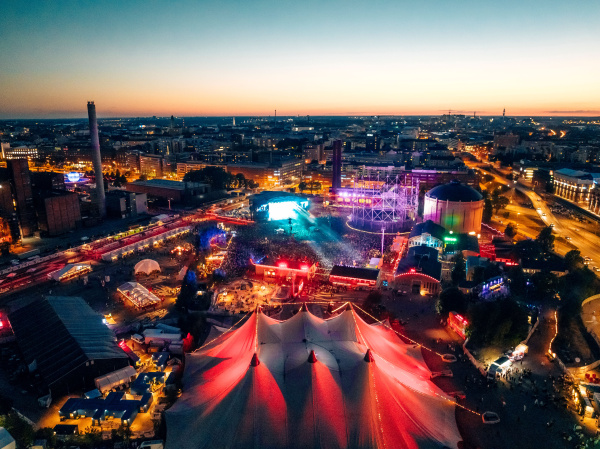
There is more and more talk about carbon budgets in climate policy, but when it comes to business and lifestyles, this is not yet the case. Decisions as individuals and businesses are still made mostly based on resources such as money and time. When we measure environmental impacts, such as carbon footprints, we focus on what has already happened and what we might be able to learn from it. Why not flip the question and start talking from a carbon budget perspective?
At D-mat we have recently been playing with the idea of carbon budgets with our client Flow Festival Ltd (Flow). Flow said at the start of our project that they felt that their carbon footprint assessments should not be done after the event, but before the event, at the same time as the financial budgets are set. This is what we are now working on now, to develop a carbon budgeting tool for events.
The case of Flow Festival
In terms of 1.5-degree lifestyles, a fair yearly carbon budget in 2030 would be 2.5 tonnes of CO₂e per person. If we divide this proportionally by the current Finnish shares for leisure, food and drink and travel, we can imagine how much of the budget we would use by attending a music festival such as Flow Festival. When it comes to Flow, we found that the visitors’ food and drinks consumption has a carbon footprint of 1.8 kg CO₂e and travel almost 22 kg CO₂e per visitor day, while the rest of the festival's footprint is 6.6 kg CO₂e per visitor day.
The carbon footprint of food and drink is almost exactly equal to the daily carbon budget of food and drink in 2030. Eating elsewhere during the festival day would require a further reduction in the festival food and drink carbon footprint, but it is already close to the carbon budget. It is interesting to note that in 2022, Flow Festival took the decision to remove all meat from the festival, which reduced the carbon footprint of food by around half.
The average Flow visitor's carbon footprint for travel is slightly more than twice the current lifestyle carbon footprint for personal travel per day and more than 17 times the average daily carbon budget for travel in 2030 - despite the fact that at Flow most visitors (around 80%) travelled from nearby, mostly by public transport, while only around 4% travelled by air. This shows that festival organisers cannot ignore the importance of travel in reducing the overall footprint of the festival.
Moreover, 60% of the average Finn's annual carbon budget for leisure activities would be eaten up by spending all three days at Flow Festival. Therefore, reducing the festival's carbon footprint allows people to spend more time on cultural activities - or at least not exceed their carbon budget in the future.
Carbon budgets as a mentality
I think there is a big difference between the following two questions:
What is your carbon footprint?
Where do you want to spend your carbon budget?
The latter gives us more power as individuals. We can make the choice ourselves and we have a clear limit to follow. As with the Climate Puzzle, we can still "shop" for actions to take, but we can learn to think about the minimum and the same limit that everyone has. I think this might also make us appreciate the experiences we have more.
But it can also help festival organisers, or any business, to think about how the products and services they produce can be sustainable. Although Flow attendees can choose what to eat at the festival, only the organisers' decision to ban meat actually reduced the carbon footprint close to the 2030 carbon budget. And the carbon footprint of the event itself (infrastructure, stages, tents, audio, etc.) can only be influenced by the organisers.
It feels quite far-fetched to imagine a world where carbon budgets are as normal as financial budgets, but we can at least think of it as a mindset or a mind game. Through education and voluntary tools to help consumers and producers visualise how much of their carbon budget they are using and what their choices mean, we can help people and businesses understand their own carbon budget more clearly. These could be games, such as the Climate Puzzle, that help you understand the size of your carbon budget, or grocery store apps that allow you to plan where you want to spend your carbon budget. In marketing, advertisements could include a statement about how much of your carbon budget will be used by attending a festival or buying a product. A challenge might be to create a universally understandable way of measuring and expressing the numbers, but thinking in terms of budgets is not a foreign concept to most of us.
Finally, what about you? What would you really like to do with your budget or the budget of your workplace? What are the things that are most important to you? As with the Climate Puzzle and choosing your own personal path to a 1.5-degree lifestyle, you do not have to be like the average, you can build your own budget.
Ursula Rinta-Jouppi, D-mat ltd.

